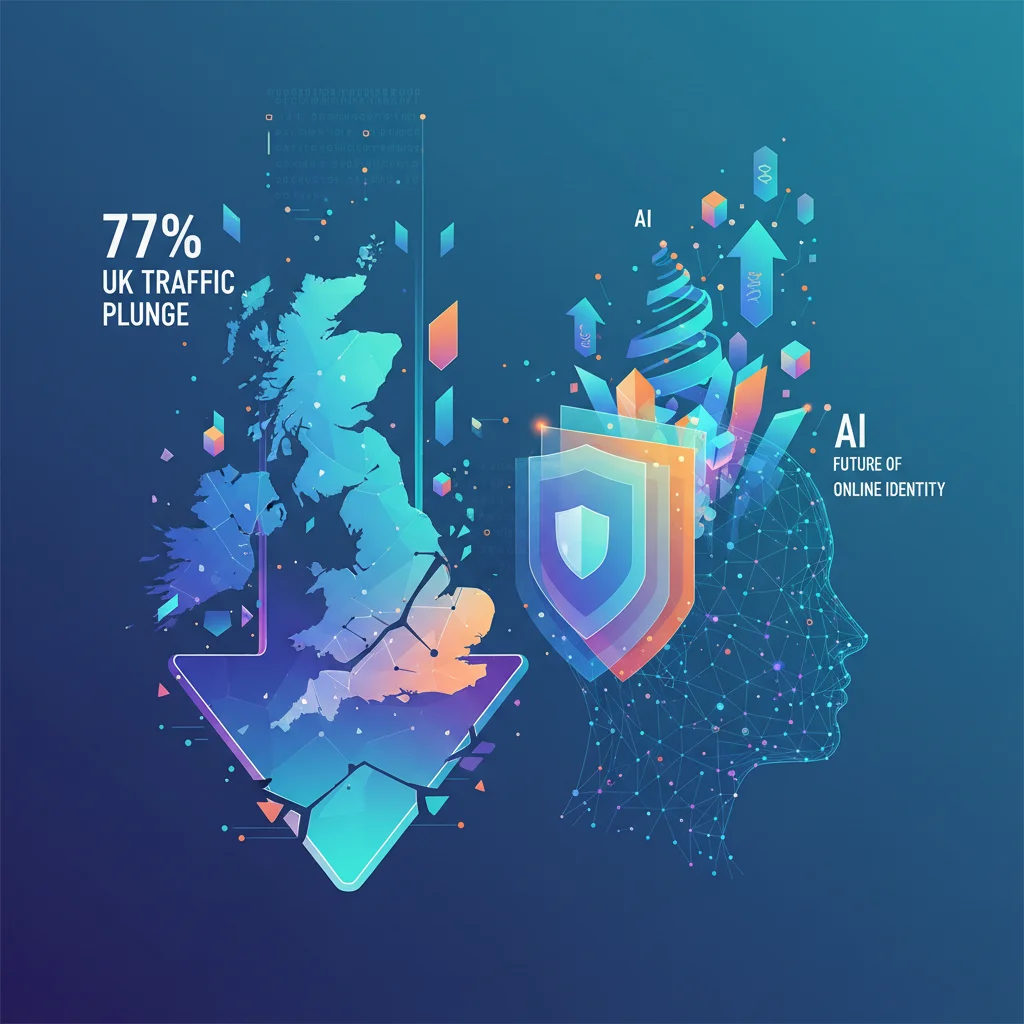
Digital Exodus: Why Pornhub’s 77% UK Traffic Plunge is a Wake-Up Call for AI, Cybersecurity, and the Future of Online Identity
It’s a headline that stops you in your tracks. Pornhub, one of the internet’s most trafficked websites, reported a staggering 77% drop in visitors from the United Kingdom overnight. This wasn’t the result of a server crash, a marketing misstep, or a sudden cultural shift. It was the direct consequence of a new law—the UK’s Online Safety Act—mandating stringent age verification for adult websites.
On the surface, this might seem like a niche story about a single industry. But look closer, and you’ll see a microcosm of the biggest challenges facing the entire tech world. This isn’t just about adult content; it’s a critical case study on the collision of regulation, user behavior, privacy, and the very technology that underpins our digital lives. The fallout from this single policy decision offers profound lessons for developers, entrepreneurs, and leaders in fields from cybersecurity and artificial intelligence to SaaS and cloud computing.
The core issue is simple: when you introduce friction, users will find a way around it. Pornhub’s parent company, Aylo, suggested that users aren’t quitting—they’re just going elsewhere. They’re either flocking to riskier, unregulated sites that don’t ask for ID, or they’re using VPNs to mask their location. This digital exodus highlights a fundamental tension: can we make the internet safer without compromising privacy or creating unintended consequences that make users *less* safe? The answer lies in technology, and the current situation is a massive wake-up call for innovation.
The Technology Behind the Gate: A Look at Modern Age Verification
To understand the user backlash, we first need to appreciate the technological and privacy hurdles that “age verification” presents. This isn’t just a simple checkbox asking, “Are you over 18?”. The UK’s law demands robust proof, forcing platforms to integrate complex, third-party verification systems. This has catalyzed a boom for “Verification-as-a-Service” (VaaS) platforms—a specialized niche within the SaaS industry.
These services, often powered by sophisticated software and hosted on the cloud, offer several methods of verification, each with its own set of trade-offs. Let’s break down the most common approaches:
1. Document Scanning (ID Verification): Users are prompted to upload a photo of their government-issued ID (like a driver’s license or passport). Optical Character Recognition (OCR), a form of AI, extracts the date of birth. This is often paired with a “liveness” check, where the user takes a selfie to prove they are the person on the ID. While accurate, the privacy implications are enormous. Users are understandably hesitant to upload their most sensitive documents to a third-party server, creating a massive potential target for data breaches.
2. Facial Age Estimation: This is where machine learning takes center stage. A user simply looks into their camera, and an AI model analyzes their facial features—wrinkles, bone structure, and other biomarkers—to estimate their age. It’s less invasive than sharing an ID, but it comes with its own problems. These AI models can have biases across different demographics, and there are still questions about what happens to the biometric data that is collected, even if it’s for a fleeting moment.
3. Digital ID Wallets: A more forward-thinking approach involves using existing digital identities, like a banking app or a government-backed digital ID, to provide a simple “yes/no” age attestation without revealing the user’s actual date of birth or name. This is a more privacy-preserving method, but it relies on widespread adoption of digital ID ecosystems, which are still in their infancy in many countries.
The implementation of any of these methods requires significant programming and integration effort, often involving complex APIs and secure data handling protocols. The challenge for developers is to build a system that is both compliant with the law and doesn’t completely destroy the user experience.
Here’s a comparative look at these technologies:
| Verification Method | Core Technology | User Friction | Privacy Risk |
|---|---|---|---|
| Document Scanning | AI (OCR), Biometrics | High (Requires finding and scanning ID) | Very High (Sensitive PII is shared) |
| Facial Age Estimation | Artificial Intelligence, Machine Learning | Low (Requires a quick selfie) | Medium (Biometric data is processed) |
| Digital ID / eID | Cryptography, Third-Party Trust | Low (Often just an app authentication) | Low (Data is minimized via zero-knowledge principles) |
As the table shows, there is no perfect solution. The most accurate methods are the most invasive, and the most convenient ones often raise questions about AI bias or data security. This is the technological tightrope that platforms now have to walk.
The Pardon That Shook Silicon Valley: What Trump's Clemency for CZ Means for the Future of Tech
The Cybersecurity Domino Effect
The conversation inevitably turns to cybersecurity. When a regulated platform becomes difficult to access, a predictable chain of events unfolds, and almost every link in that chain represents a new security risk for the end-user.
First, as Pornhub’s parent company noted, users are likely migrating to sites that have no verification, no moderation, and often, no scruples. These sites are frequently riddled with malware, phishing scams, and aggressive tracking scripts designed to harvest user data. In this scenario, the user has traded the perceived risk of sharing their ID for the very real and immediate risk of a device infection or financial fraud.
Second is the surge in VPN usage. While VPNs are legitimate and powerful privacy tools, they are not a silver bullet. Free VPN providers, in particular, often have questionable business models. Many monetize by logging user activity and selling that data to third parties—completely defeating the purpose of using a VPN for privacy. Users seeking a “quick fix” may inadvertently be handing their entire browsing history over to a shady operator. This creates a new attack vector that didn’t exist when they were accessing the content directly.
For startups and established companies alike, this user behavior is a lesson in threat modeling. You must consider not only the direct threats to your platform but also the “downstream” risks your users expose themselves to when they are unable or unwilling to use your service as intended. Effective cybersecurity isn’t just about building walls around your own garden; it’s about understanding the entire ecosystem your users inhabit.
Your Snack Could Get You Arrested: When AI-Powered Security Goes Terribly Wrong
An Opportunity for Innovation: The Future of Digital Identity
While the current situation seems bleak, it also represents a massive opportunity for technological innovation. The market is screaming for a better solution—a way to verify age and identity that is secure, private, and seamless. This is a challenge tailor-made for ambitious developers, entrepreneurs, and thinkers in the digital identity space.
What could this future look like? The answer lies in moving away from centralized, data-hoarding models and toward user-centric, decentralized systems. Concepts that were once theoretical are now becoming practical necessities:
- Zero-Knowledge Proofs (ZKPs): Imagine being able to prove you are over 18 without revealing your date of birth, your name, or any other piece of personal information. This is the magic of ZKPs. A user’s identity is verified once and stored securely on their own device. When a site needs to check their age, the device can provide a cryptographic “yes” without transmitting any underlying data. This requires advanced programming and a robust public key infrastructure, but it’s the holy grail of private identity verification.
- Decentralized Identifiers (DIDs): Instead of relying on a handful of corporate or government entities to hold our identity, DIDs allow individuals to control their own digital credentials. You could have a “verified credential” for your age from a trusted source (like a government agency) stored in your personal digital wallet, which you could then present to any website that needs it.
- On-Device AI Processing: To address the privacy concerns of facial age estimation, future AI models could be designed to run entirely on the user’s device (on-the-edge computing). The user’s camera feed is analyzed locally, and only the result (e.g., “age > 18”) is sent to the server. No biometric data ever leaves the phone or computer, drastically reducing the risk.
These solutions require a paradigm shift in how we think about identity software. They demand a move towards automation in cryptographic processes and a focus on open standards that allow different systems to trust each other. The companies and startups that crack this code won’t just solve the age verification problem; they’ll build the foundational layer for the next generation of digital trust online.
Conclusion: More Than Just a Statistic
The 77% traffic drop in the UK is far more than a statistic in a corporate press release. It’s a stark, real-world experiment playing out at the intersection of law, ethics, and technology. It proves that in the digital realm, you cannot simply legislate user behavior without providing technologically sound, user-friendly alternatives. Pushing users towards less secure options is not a victory for safety.
For the tech industry, this is a call to action. The demand for privacy-preserving identity solutions has never been greater. The fields of artificial intelligence, cybersecurity, and decentralized systems hold the keys. The challenge is to move beyond clunky, invasive methods and build a future where proving who you are online is as simple and secure as tapping your phone, without having to give away the keys to your digital kingdom. The companies that lead this charge won’t just be building a compliance tool; they’ll be building the future of digital freedom and trust.
The AI Glitch That Saw a Gun: Why a Teen's Doritos Snack Is a Wake-Up Call for All of Tech


